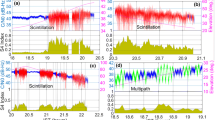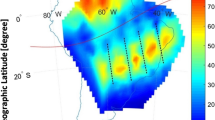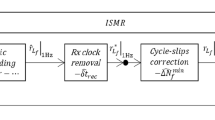Abstract
Ionospheric scintillation causes noise in GNSS measurements and hence affects the resulting coordinates or even the ability to track data. We investigate the characteristics of GNSS scintillation during a visible aurora borealis event over the Faroe Islands during October 7, 2018, which lasted for around 30 min. Data of 1 Hz rate from a typical geodetic GNSS receiver are analyzed during a 3-h window around the event, as well as during the same period the days before and after. Data from all four GNSS are analyzed, which consist of 31 satellites during the occurrence, resulting in a good overview of the temporal distribution of the scintillation. Two approaches are used, called the time difference code-minus-carrier and the time difference phase ionospheric residual. The results illustrate that there is little effect on the code measurements, but significant repercussion on the carrier phase observables, resulting in erroneous position solutions. The approaches we present can be used in GNSS processing software to detect scintillation noise in real time on individual satellites, allowing such noisy data to be rejected.









(Source: Space Weather Prediction Center, National Oceanic and Atmospheric Administration)

(Source: British Geological Survey, World Data Centre for Geomagnetism (Edinburgh))

Similar content being viewed by others
References
BDS-SIS-ICD-2.1 (2016) BeiDou navigation satellite system signal in space interface control document—open service signal (version 2.1). China Satellite Navigation Office, Beijing
Bruyninx C, Habrich H, Söhne W, Kenyeres A, Stangl G, Völksen C (2012) Enhancement of the EUREF permanent network services and products. Geod Planet Earth IAG Symp 136:27–35. https://doi.org/10.1007/978-3-642-20338-1_4
Cai C, Liu Z, Xia P, Dai W (2013) Cycle slip detection and repair for undifferenced GPS observations under high ionospheric activity. GPS Solut 17(2):247–260. https://doi.org/10.1007/s10291-012-0275-7
Circiu MS, Meurer M, Felux M, Gerbeth D, Thölert S, Vergara M, Enneking C, Sgammini M, Pullen S, Antreich F (2017) Evaluation of GPS L5 and Galileo E1 and E5a performance for future multifrequency and multiconstellation GBAS. Navigation 64(1):149–163. https://doi.org/10.1002/navi.181
Crane RK (1977) Ionospheric scintillation. Proc IEEE 65:180–199. https://doi.org/10.1109/PROC.1977.10456
D’Angelo G, Spogli L, Cesaroni C, Sgrigna V, Alfonsi L, Aquino MHO (2015) GNSS data filtering optimization for ionospheric observation. Adv Space Res 56(11):2552–2562. https://doi.org/10.1016/j.asr.2015.10.002
de Bakker PF, van der Marel H, Tiberius CCJM (2009) Geometry-free undifferenced, single and double differenced analysis of single frequency GPS, EGNOS and GIOVE-A/B measurements. GPS Solut 13(4):305–314. https://doi.org/10.1007/s10291-009-0123-6
GLONASS-SIS-ICD-5.1 (2008) Global Navigation Satellite System GLONASS Interface Control Document Navigation Radio Signals in bands L1, L2, edition 5.1. Russian Institute of Space Devise Engineering, Moscow
Guo K, Zhao Y, Liu Y, Wang J, Zhang C, Zhu Y (2017) Study of ionospheric scintillation characteristics in Australia with GNSS during 2011–2015. Adv Space Res 59(12):2909–2922. https://doi.org/10.1016/j.asr.2017.03.007
Huang L, Lu Z, Zhai G, Ouyang Y, Huang M, Lu X, Wu T, Li K (2016) A new triple-frequency cycle slip detecting algorithm validated with BDS data. GPS Solut 20(4):761–769. https://doi.org/10.1007/s10291-015-0487-8
IS-GPS-200J (2018) Interface specification IS-GPS-200. Navstar GPS space segment/navigation user interfaces, revision J, July 2018
Jiang Y, Milner C, Macabiau C (2017) Code carrier divergence monitoring for dual-frequency GBAS. GPS Solut 21(2):769–781. https://doi.org/10.1007/s10291-016-0567-4
Luo X, Liu Z, Lou Y, Gu S, Chen B (2017) A study of multi-GNSS ionospheric scintillation and cycle-slip over Hong Kong region for moderate solar flux conditions. Adv Space Res 6(5):1039–1053. https://doi.org/10.1016/j.asr.2017.05.038
Marques HAS, Monico JFG, Marques HA (2016) Performance of the L2C civil GPS signal under various ionospheric scintillation effects. GPS Solut 20(2):139–149. https://doi.org/10.1007/s10291-015-0472-2
Mushini SC, Jayachandran PT, Langley RB, MacDougall JW, Pokhotelov D (2012) Improved amplitude- and phase-scintillation indices derived from wavelet detrended high-latitude GPS data. GPS Solut 16(3):363–373. https://doi.org/10.1007/s10291-011-0238-4
Myer G, Morton Y, Schipper B (2017) Ionospheric scintillation effects on GPS pseudorange and carrier phase measurements and an adaptive algorithm to limit position errors during scintillation. In: Proceedings of ION GNSS 2012, Institute of Navigation, Nashville, Tennessee, USA, Sept 17–21, pp 3055–3065
OS-SIS-ICD-1.2 (2015) European GNSS (Galileo) Open service—signal in space interface control document, Issue 1.2. European Union, Brussels
PS-QZSS-001 (2018) Quasi Zenith Satellite System Performance Standard. Japan Cabinet Office, November 5, 2018
Roberts GW (2019) Noise comparison of triple frequency GNSS carrier phase, doppler and pseudorange observables. Measurement 144(2019):328–344. https://doi.org/10.1016/j.measurement.2019.05.011
Romano V, Spogli L, Aquino M, Dodson A, Hancock C, Forte B (2013) GNSS station characterisation for ionospheric scintillation applications. Adv Space Res 52(7):1237–1246. https://doi.org/10.1016/j.asr.2013.06.028
Seeber G (2003) Satellite geodesy: foundations, methods, and applications, 3rd edn. Walter De Gruyter, Berlin, pp 240–243
Skone S (2001) The impact of magnetic storms on GPS receiver performance. J Geod 75(9–10):457–468. https://doi.org/10.1007/s001900100198
Skone S, El-Gizawy M, Shrestha S (2001) Limitations in GPS positioning accuracies and receiver tracking performance during solar maximum. In: Proceedings of the international symposium on kinematic systems in geodesy, geomatics, and navigation. Banff, Alberta, June 5–8, pp 129–143
Tang L, Zheng K, Li X (2017) Analysis of geometry-free residuals in case of traveling ionosphere disturbances and their impact cycle slip detection. GPS Solut 21(3):1221–1226. https://doi.org/10.1007/s10291-017-0606-9
van der Meeren C, Oksavik K, Lorentzen DA, Rietveld MT, Clausen LBN (2015) Severe and localized GNSS scintillation at the poleward edge of the nightside auroral oval during intense substorm aurora. J Geophys Res Space Phys 120(12):10607–10621. https://doi.org/10.1002/2015JA021819
Van Dierendonck AJ, Klobuchar J, HuaIonospheric Q (1993) Scintillation monitoring using commercial single frequency C/A code receivers. In: Proceedings of ION GPS 1993, Institute of Navigation, Salt Lake City, USA, Sept 22–24, pp 1333–1342
Zhao D, Hancock CM, Roberts GW, Jin S (2019) Cycle slip detection during high ionospheric activities based on combined triple-frequency GNSS signals. Remote Sens 11(3):250. https://doi.org/10.3390/rs11030250
Acknowledgements
The authors are grateful to both the Faroese Environment Agency (Umhvørvisstovan) and the Danish Agency for Data Supply and Efficiency (SDFE) for access to the GNSS data. Geoscience Australia and NRCan are also acknowledged for the use of AUSPOS and CSRS-PPP online GNSS processing software. NOAA is acknowledged for access to the Kp values, and the British Geological Survey is acknowledged for access to the hourly geomagnetism data at Lerwick.
Author information
Authors and Affiliations
Corresponding author
Additional information
Publisher's Note
Springer Nature remains neutral with regard to jurisdictional claims in published maps and institutional affiliations.
Rights and permissions
About this article
Cite this article
Roberts, G.W., Fossá, S. & Jepsen, C. Temporal characteristics of triple-frequency GNSS scintillation during a visible aurora borealis event over the Faroe Islands amid a period of very low solar activity. GPS Solut 23, 89 (2019). https://doi.org/10.1007/s10291-019-0881-8
Received:
Accepted:
Published:
DOI: https://doi.org/10.1007/s10291-019-0881-8




